 |
||
|
||
| ||
 Contents
Hightech Information System Ltd (HIS) was established by 4 enthusiastic Christian computer specialists in 1987 in Hong Kong with the aim of Glorifying God. I have never met such a statement before. In the beginning the company got by with small production lines in Hong Kong but then they moved to China and built there a big modern plant which now keeps on manufacturing HIS video cards. Till recently the company was focused on the NVIDIA's processors and brought out full series of cards on almost all chips of this Californian company. They also produced small lots on the SIS 300-305-315 and Trident Blade3D,XP. But the today's beacon is ATI, and there are almost all cards on the RADEON 7500/8500/9000/9500/9700. As usual, expansion of the ATI line means phasing out the NVIDIA line, and the last product they used was the GeForce3 Ti 500. Although the GeForce4 MX 440 is also involved, this card stands apart and I think it's not a result of agreement with NVIDIA, but the card is built on chips coming from the gray market. What can we say about solutions of this firm? Almost nothing. Some time ago we examined the Trident BladeXP based card, but because of the chipset and drivers the card didn't impress us at all, though its build quality was quite good. Note that for cheap cards the company uses its own designs instead of the reference ones. HIS also makes high-end models. In particular, the above mentioned GeForce3 Ti 500 was referred to the high-end level at that time, and now this is ATI RADEON 9700 Pro. By the way, our shelves have already a lot of reviews of such cards: Theoretical materials and reviews of video cards which concern functional
properties of the VPU
Today we have in our lab the HIS Excalibur RADEON 9700 Pro. It's actually a copy of the reference sample. Moreover, I think it was manufactured at the PC Partner's factory. As you know, first RADEON 9700 Pro based cards were made at the same factory and then the partners stuck their names and numbers and packed them into their boxes. It was done to give them time to prepare for such a complicated layout and in order not to lose time by selling cards made by the OEM orders. That is why only the Hercules's card had a PCB of a different color, and the rest were exact copies of the reference design. The key task for today is to test the RADEON 9700 Pro in the DirectX 9.0 RC0, which is possible due to the already released API and ATI's drivers for it and the RADEON 9500/9700. But first of all let's have a gander at the card itself. Card
Well, it really is a pure copy of the reference design, including the cooler. Under the cooler we have the VPU RADEON 9700 Pro.  If we peep into the box we will see that the card comes with the following stuff: 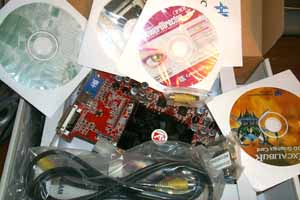 Contrary to the Canadian producer which thinks that games are unnecessary, HIS supplies one, though it's an old game. There is also Cyberlink PowerDirector, which is usually used for management of Video-In that lacks in the RADEON 9700 Pro. Isn't it strange? :-) The CD with PowerDVD XP is an advantage. The box is of typical dimensions with an exotic combination of cold steel and horns (at least, there are no monsters). 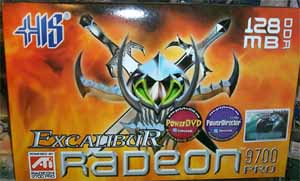 Overclocking
The overclockability is average, because the surrounding frame is higher than the die, and the cooler doesn't pressed firmly against the chip despite the thermo pad. Note

Test system and driversTestbed:
The test system was coupled with In the tests we used ATI's drivers 6.200 (with DirectX 8.1) and 6.228 (with DirectX 9.0 RC0). VSync was off in the drivers, texture compression was off in the applications. Texture detail level set to High Quality. For comparison we used results of the following video cards:
Drivers' settingsThe DirectX 9 drivers are still going through the beta tests, that is why we tested the RADEON 9700 Pro in DX9 in the synthetic tests which are written by the developers of the RightMark 3D packet. Also, we will estimate the difference in performance of the RADEON 9700 Pro in case of different drivers and APIs. All the driver settings were described in the articles listed above (it's the same for the drivers 6.228). Test results2D graphicsAs you understand, the 2D quality won't be different from other such cards as this one is simply a copy of the reference sample. And earlier we wrote that the 2D quality was satisfactory. Remember that estimation of 2D quality can't be objective. It depends on quality of a sample, and a card/monitor tandem (you should pay special attention to quality of the monitor and the cable). 3D graphics, GPUSpeed and PixelShaderSpeed synthetics tests in DirectX 9.0It's clear that ATI was in such a hurry with the new drivers for the unreleased final version of the DirectX to show capabilities of the RADEON 9700 Pro in the DEMO programs. That is why when the DirectX 9.0 RC0 became available for download at one's own risk (this is still a beta version), ATI also offered the 6.228 beta of its drivers for the RADEON 9500/9700 for Windows XP. Certainly, they warn us multiple times that the developer is not responsible for any damages caused by this software bundle, but still, is it possible to resist watching such beautiful images as though they are video clips?!   Here they use rendering of extra (floating-point) precision with an extended dynamic range. An image goes through gamma correction before rendering. Besides, pixel shaders are used to describe the material that reflects the environment on balls.   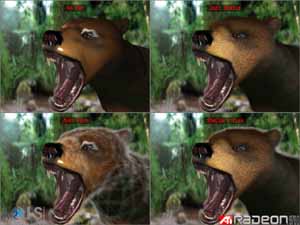 This demo uses a lot of techniques, and first of all, vertex shaders for hair and animation of the bear.    Here we can see complex metallic material of unusual color whose optical properties are modeled with a pixel shader according to quite a lengthy formula from the optics. Besides, here we have Displacement Mapping going along with n-patches of a new order :-), a fine relief on the car is formed not at the model's level (i.e. long before operation of the video processor), but by the VPU according to a given displacement texture. 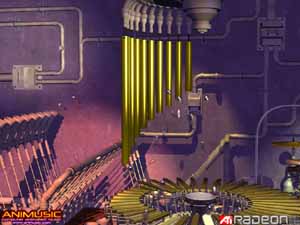 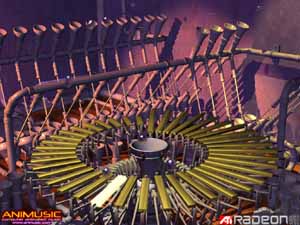 This is a good demonstration of how the technologies have recently changed. It wasn't long ago when this clip of playing some musical instruments created a furor in precision and coherence of rendering and a musical theme - at that time it was needed over a dozen of computers to calculate each frame of this clip in the software mode. And now a single video card is able to produce not just THE SAME, but even something more sophisticated. Various shaders are used to deliver properties of materials and for animation. Besides, the geometry detail level certainly corresponds to the performance of the latest VPUs. And now I'm turning back to the synthetic programs which were used earlier in the RADEON 9700 Pro Review. But that time we didn't have the DX9 driver. GPUSpeedFirst of all, let's compare performance of the accelerators in the fixed T&L emulation mode. In the test 1 we have only the constant background lighting. It's the simplest case - we apply the same color value to each vertex. This mode will show us the peak accelerator's performance in terms of triangles. As expected, it's limited by the GPU (or VPU) and doesn't depend on the API version. The RADEON 9700 PRO processes around 106 M triangles, while the GeForce 4 Ti 4600 copes only with 70 M. But in the more complex lighting modes the GeForce 4 is catching up! It implies that it has more advanced T&L emulation or processes complex vertex shaders more efficiently. In the 7th test (3 diffused and 2 specular spot light sources) NVIDIA gets the palm despite only 2 execution vertex units against 4 of the RADEON. In future, when the DirectX 9 and respective drivers will appear, and final versions of the NV30 based cards will be developed, we will carefully study effectiveness of T&L emulation and execution of vertex shaders for all chips of the NV25, NV30 and R300 families. Now let's see how performance depends on a version of the vertex shaders, API version and a filling type used together with vertex shaders - pixel shaders or fixed function filling in the old manner. Note that the test looks quite weird for vertex shaders 2.0 + pixel shaders 2.0. It's caused by a strange behavior of the DirectX beta - I suppose an error occurs when the correct shader code is compiled (which is executed without errors on the reference software rasterizer of DX9). It can be the raw drivers or API to blame - anyway, let's wait for the official release. Note that the results of the similar second and first vertex shaders should be almost identical. The main reason is backward compatibility. But the vertex shaders 2.0 contain loops which did work although in the DirectX beta loops are not compiled correctly every time (sic!). In case of the RADEON loops pull down the performance by about 20%. It is more than the expected cost for one additional compare and branch command for each light source - this is where the shaders with loops differ from manually unrolled shaders. It's especially amazing given to the fact that the R300 doesn't support dynamic jumps in the shaders, and for loading into the chip the shaders must be unrolled by the drivers the same way as we did it manually in the shaders 1.1. Probably, this will be solved in the optimized drivers and API - but the developers should be ready for the cost of handy commands of loops and subroutine call even in case of the static management of the command flow. So, in real applications the beta tandem of the API and DX9 drivers is still too raw. At last, let's see whether the test depends on a resolution. Ideally, a synthetic test of the geometrical chip performance mustn't depend on it, and it was almost so. At the same time, it does depend on the shader's complexity, which was expected. PixelShaderSpeedWell, the pixel shaders 2.0 exist and work error-free! Note that the last 7th shader draws a sophisticated animated procedural texture and is executed much faster than the 5th shader which is responsible for classical per-pixel lighting. A procedural texture is more calculation-oriented, while the 5th shader is mostly for texture fetching. Thus we have the computational balance of the new architectures which was so much spoken about! It's possible that future applications will use procedural textures which in some cases can be more handy in use and in terms of performance. At last, let's see whether there is difference in case of pixel shaders used with hardware vertex ones or with their software emulation. This test will show how the test of pixel shaders depends on environment. Well, some dependence becomes apparent only with the procedural texture which requires intensive preparation of initial parameters. So, everything is OK with the pixel shaders, and we are only to wait for the final versions of the API, drivers and NV30 cards to find out who is who in the issues of peak performance of shader units. Operation with the vertex shaders involved is a bit strange. Let's wait for tweaking up. 3D graphics, 3DMark2001 - gaming tests3DMark2001, 3DMARKSIn case of the DX81 drivers the API DX9 forces down the speed of the RADEON 9700 Pro, while the new drivers improve the situation. 3DMark2001, Game1 Low details
It's almost the same here; besides, the given test much depends on the CPU.
3DMark2001, Game2 Low detailsAnd here operation of the RADEON 9700 Pro in the DX9 is rather efficient.
3DMark2001, Game3 Low detailsAgain, the speed falls down with the previous drivers on the DX9, and goes up again with the 6.228 version. 3DMark2001, Game4For such complex test which is only DX8-oriented the DX9 brought excellent scores, especially to the RADEON 9700 Pro. In general, in the 3DMark2001 the new driver 6.228 coupled with the DX9 RC0 made operation of the RADEON 9700 Pro much better. 3D graphics, gaming testsFor estimation of 3D performance in games we used the following tests:
Quake3 Arena, QuaverWhy do we test OpenGL applications here? Because beside Direct3D the DirectX contains many other components which are intensively used by OpenGL games (DirectSound, DirectInput). As for the RADEON 9700 Pro, it's possible that the situation will be similar to the 3DMark2001. But the game shows that the DX9 is still too raw. The game jerks and slows down even with the DX8 drivers (together with DX9), not to mention the DX9 drivers. Serious Sam: The Second Encounter, Grand CathedralIn this test the RADEON 9700 Pro on the DX9 drivers and in the DX9 as a whole have lower scores, though no jerking or slowing down was noticed. Return to Castle Wolfenstein (Multiplayer), CheckpointThe Ti 4600 won with the DX9 (the drivers are under DX81) while the RADEON 9700 Pro lost. ATI has much to do about the drivers and MS about the DX9. Comanche4 DEMOThe game is so processor-dependent that we have nothing to say about the performance difference. Unreal Tournament 2003 DEMOThe new game UT2003 gets the second wind with the new DX9 when coupled with the RADEON 9700 Pro. AquaMarkNow the companies deserve only rotten apples :-). But remember, it's only the beta version of the DX9 and its drivers. RightMark 3DThe situation is smooth. Operation of the shaders 1.1 and 1.3 is not something the new software of MS and ATI bothers about :-). Conclusion
I think the RADEON 9700 Pro has every chance to look more attractive than
the NV30, at least, in the near future, taking into account the initially
overpriced GeForce, price cuts for the RADEON 9700 Pro, and a possible
release of a debugged DX9 driver by ATI by the release of the DX9, because
it's not necessary to change the hardware as NVIDIA doesn't have yet the
final revision of the NV30 chip, and it's needed to test thoroughly both
the software and hardware.
Andrey Vorobiev (anvakams@ixbt.com)
Write a comment below. No registration needed!
|
Platform · Video · Multimedia · Mobile · Other || About us & Privacy policy · Twitter · Facebook Copyright © Byrds Research & Publishing, Ltd., 1997–2011. All rights reserved. | ||||||||||||||||||||||||||||||||||||||||||||||||||||||||||||||||||||||||||